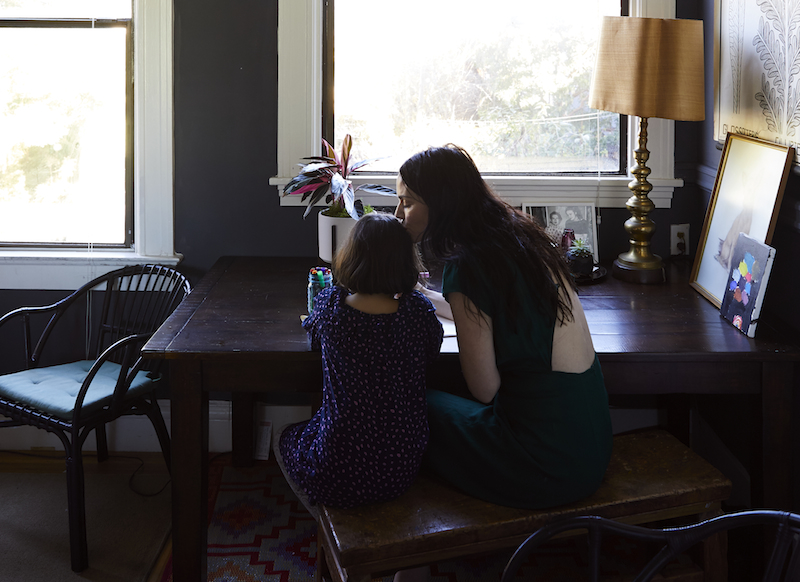
How to Talk to Kids About Mass Shootings & Other Tough Topics
Written by
Caroline Knorr via Common Sense Media
Photography by
PHOTOGRAPHED BY AUBRIE PICK
Mass shootings. Nuclear weapons. A robbery at your local corner store. Where do you start when you have to explain this stuff to your kids? News of three mass shootings in just one week’s time has many parents grappling, yet again, with the question of what to say to their children about the horrific images on newsstands and T.V. screens everywhere. It’s unavoidable—issues involving violence, crime, and war, whether they’re in popular shows, video games, books, or news coverage, reach even the youngest kids. And with wall-to-wall T.V. coverage, constant social media updates, streaming services that broadcast age-inappropriate content any time of day, plus the internet itself, you have to have a plan for discussing even the worst of the worst in a way that’s age-appropriate, that helps kids understand, and that doesn’t cause more harm.
We know that kids report feeling afraid, angry, or depressed about the news. But in recent years—prompted by increased terrorist attacks around the world and mass shootings here in America—researchers are exploring the effects of “remote exposure” to real violent events. Remote exposure is when kids understand that something traumatic has occurred but haven’t experienced it directly. Unsurprisingly, its lingering effects include feelings of grief, trauma, fear, and other mental health concerns. Kids can be deeply affected by images of the aftermath of a mass shooting, and especially school children who look like them fleeing their classrooms in fear, and need additional help processing them.
These tips and conversation starters below can help you talk to kids of different ages about the toughest topics—including violence, crime, and war.
Age 2–6
Avoid discussion of or exposure to really horrific news. As much as possible, wait until after young kids are in bed to watch the news, and save conversations about heinous subjects, such as Charles Manson or the latest Dateline murder mystery, for child-free moments.
Don’t bring it up—unless you think they know something. There’s no reason to bring up school shootings, terrorist attacks, threats of war, or the like with young kids. If you suspect they do know something—for example, you hear them talking about it during their play—you can ask them about it and see if it’s something that needs further discussion.
Affirm that your family’s safe. In the case of scary news, such as wilderness fires—even if you’re a little rattled—it’s important for young children to know they’re safe, their family is O.K., and someone is taking care of the problem. Hugs and snuggles do wonders, too.
Simplify complex ideas—and move on. Abstract ideas can complicate matters and may even scare young kids. Use concrete terms and familiar references your kid will understand, and try not to over-explain. About a mass shooting, say, “A man who was very, very confused and angry took a gun and shot people. The police are working to make sure people are safe.”
Distinguish between “real” and “pretend.” Young kids have rich fantasy lives and mix up make-believe and reality. They may ask you if a scary story is really true. Be honest, but don’t belabor a point.
Age 7–12
Wait and see. Unless they ask, you know they were exposed, or you think they know something, don’t feel you have to discuss horrific news or explain heinous crimes such as rape, beheadings, dismemberment, and drug-fueled rampages (especially to kids in the younger end of this age range or who are sensitive). If kids show signs of distress by acting anxious, regressing, or exhibiting some other tip-off that something’s amiss—for example, they’re reluctant to go to school after the latest school shooting—approach them and invite them to talk.
Talk…and listen. Older tweens hear about issues related to violence, crime, and war on social media, YouTube, TV, and movies—not always reliable sources for facts. Try to get a sense of what your kids know before launching into an explanation, since you don’t want to distress them further or open up a whole new can of worms. Feel them out by asking, “What did you hear?,” “Where did you hear that?,” “What do you know about it?,” and “What do you think about it?”
Be honest and direct. Tweens can find out what they want to know from different sources, and you want the truth to come from you. It’s not necessary to go into extreme detail. About a family who held their kids hostage, you can say, “The kids suffered many different kinds of abuse. But they were rescued, and their parents were arrested. Often in cases of child abuse, the parents are very sick with mental illness or other issues.”
Discuss sensationalism in news and media. Talk to kids about how media outlets—including news agencies, TV shows, movie companies, and game developers—use extreme subjects to get attention, whether it’s in the form of clicks, viewership, or ticket sales. Share the old newsroom adage, “If it bleeds, it leads,” and talk about why we may be drawn to outrageous human behavior. This helps kids think critically about the relative importance of issues, the words and images used to attract an audience, and their own media choices.
Explain context and offer perspective. With your life experience, knowledge, and wisdom, you can explain the various circumstances around certain issues. This is the process that gives things meaning and clarity—and it’s important for kids to be able to make sense of negative and unpleasant things, too. To work through the powerful emotions that images of beatings, blood, and human suffering can bring up, kids have to learn to distance themselves from horrific events, understand the underlying causes, and perhaps get involved in meaningful ways to make things better, such as diplomacy and education.
Teens
Assume they know—but don’t assume their knowledge is complete. Teens get a lot of their information from online sources such as social media or YouTube, which can be misleading or flawed. Still, it’s important to respect their knowledge and ability to learn things independently because that’s a process you want to foster. You’ll still need to fill in the blanks, offer some history, and share what you know.
Get them talking. High school years can be tough, as teens start rejecting their parents’ ideas, becoming concerned with what friends think, and developing their own voice. This separation can be especially difficult when traumatic events occur or when you know they’re interacting with mature media. To continue the kinds of conversations you had when they were younger—and stay connected and relevant—resist the urge to lecture and instead ask their opinions about things. Encourage them to support their ideas with legitimate news sources, not just repeat what others have said. Say, “We may not always agree, but I’m curious to hear what you have to say.”
Accept their sources, but expand their horizons. Trending topics capture the headlines, but teens are just as likely to run across provocative subjects, stories, and characters on TV and in movies—such as the meth-making chemistry teacher of Breaking Bad—that get users clicking, viewing, and sharing. Give teens the tools to view information critically, whether they’re scrolling through Snapchat, Netflix, or a free-speech site for extremists such as 4chan and 8chan. Teach them to question what they see by asking themselves, “Who made this?,” “Why did they make it?,” “What’s its point of view?,” “What information isn’t included?,” and “What would my friends think of this?” These media-literacy questions help teens evaluate information, think beyond the clickbait headline or funny meme, and look more deeply into a topic.
Offer hope. Mood swings are the hallmark of the teen years. But exposure to sad and depressing news, as well as to issues like violence, crime, and war, through social media, video games, and movies can make teens world-weary. Don’t be a Pollyanna (teens will see through that), but talk about meaningful ways to contribute something to the world—anything that benefits the greater good. The idea that you can make a positive impact restores the soul and boosts the resilience they’ll need their whole lives.
Need more advice? Read these Common Sense Media stories about explaining distressing news, difficult subjects, and sexual harassment to children.
Share this story



